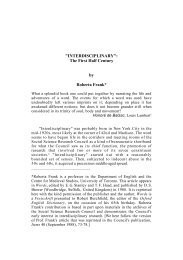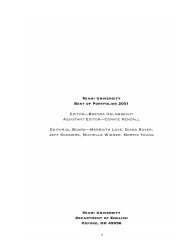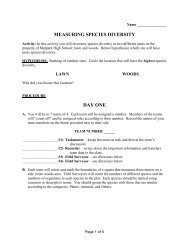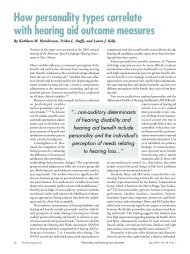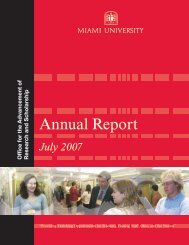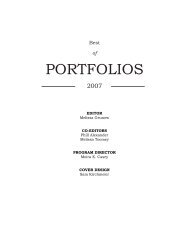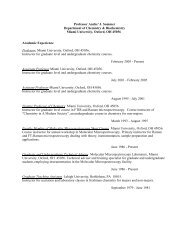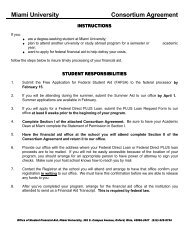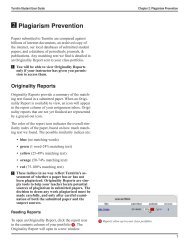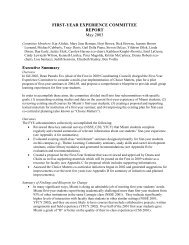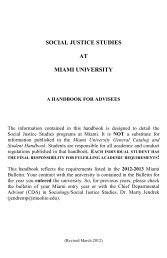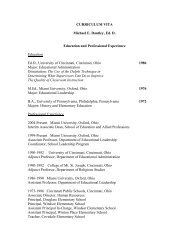Interdisciplinary Research Manual - Units.muohio.edu
Interdisciplinary Research Manual - Units.muohio.edu
Interdisciplinary Research Manual - Units.muohio.edu
Create successful ePaper yourself
Turn your PDF publications into a flip-book with our unique Google optimized e-Paper software.
11<br />
stock of what you have to work with (i.e., evaluating sources). It is an on-going<br />
instrument that you update and use for your own purposes throughout the project.<br />
Whenever feasible, sit in front of your computer when you look through the books<br />
you've selected from your on-line search for closer examination. Once you have<br />
determined that the book is useful for your project (see Evaluating Sources below), start<br />
by entering the full bibliographic citation (author, title, edition, city/publisher/date for<br />
books; website for electronic sources). Try using easybib.com or RefWorks (see below).<br />
In the humanities and social sciences, there are usually sufficient books to<br />
complete the bibliography. In the natural sciences, you may exhaust the relevant books<br />
fairly quickly and need to move into the journal literature.<br />
There are a number of standard styles for bibliographies and footnotes—APA<br />
(American Psychological Association), MLA (Modern Language Association), etc. The<br />
rules for each style are available at http://www.lib.<strong>muohio</strong>.<strong>edu</strong>/onlineref/; click on<br />
Citation Guides and Style <strong>Manual</strong>s. Since you want to make your project as credible as<br />
possible in the eyes of the experts you want to read your project, you should adopt the<br />
style used by the majority of your sources. Once you have identified the appropriate style<br />
for your project, you need to put all citations in that format, even sources drawn from<br />
disciplines that use another style. Follow the style you have chosen down to the smallest<br />
detail, including where spaces go in a citation, and whether you use periods or commas<br />
after each section of the citation. Unfortunately, scholars tend to get rather pedestrian<br />
when it comes to citations in bibliographies and footnotes, and they form an impression<br />
of the overall quality of your work from such academic minutiae. Instead of bemoaning<br />
this fact, you might as well recognize it and become a bit compulsive about following the<br />
particular style you adopt. Simple ways to handle formatting of citations is to use<br />
RefWorks, available on the library website under <strong>Research</strong> Resources, or easybib.com.<br />
In your annotation: 1. Identify the perspective (e.g., sociological or feminist) from<br />
which it is written; for edited collections, identify perspectives of the contributors you<br />
expect to use as well as of the editors. Use the predominance of that discipline or<br />
interdiscipline in the bibliography, the author’s title (e.g., Professor of Physics), or<br />
information in the preface or introduction to guide you; when all else fails, google the<br />
author’s name. 2. Identify (ideally in the author’s or editor’s own words) both the focus<br />
of the work and the approach it takes (each will typically be identified in the<br />
Introduction). 3. Identify the aspect of the book that seems particularly appealing at the<br />
moment. See Evaluating Sources below for how to identify this information most<br />
efficiently.<br />
You want to identify perspectives, but not clutter up your annotation with<br />
extraneous detail: Label the perspective; don’t present a mini-biography. For example,<br />
say: The author is a social worker who directs a sexual assault clinic; the editors are from<br />
law and psychiatry as well as child abuse activists. Not: “Berliner has an MSW and is the<br />
Director of the Harborview Center for Sexual Assault and Traumatic Stress in Seattle.<br />
Briere has a PhD and is an Associate Professor of Psychiatry and Psychology. Hendrix<br />
has an MA and an active member of the American Professional Society on the Abuse of<br />
Children (APSAC). Jenny has a MD and a MBA and was the Executive Director of<br />
APSAC. Reid has a PhD and works in Children’s Advocacy.”<br />
The point of identifying an author's institutional affiliation is not to establish that<br />
person’s professional credentials, but to help identify the person's disciplinary



